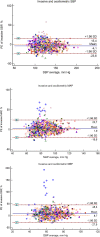Factors influencing the accuracy of non-invasive blood pressure measurements in patients admitted for cardiogenic shock
- PMID: 31215405
- PMCID: PMC6582540
- DOI: 10.1186/s12872-019-1129-9
Factors influencing the accuracy of non-invasive blood pressure measurements in patients admitted for cardiogenic shock
Abstract
Background: Although invasively measured blood pressure (invBP) is regarded as a "gold standard" in critically ill cardiac patients, the non-invasive BP is still widely used, at least at the initiation of medical care. The erroneous interpretation of BP can lead to clinical errors. We therefore investigated the agreement of both methods with respect to some common clinical situation.
Methods: We included 85 patients hospitalized for cardiogenic shock. We measured BP every 6 h for the first 72 h of hospitalization, in all patients. Each set of BP measurements included two invasive (invBP), two auscultatory (auscBP), and two oscillometric (oscBP) BP measurements. InvBP was considered as a gold standard. Mean non-invasive arterial pressure (MAP) was calculated as (diastolic pressure + (pulse pressure ÷ 3)). We used Bland-Altman analysis and we calculated concordance correlation coefficients to assess agreement between different BP methods.
Results: We obtained 967 sets of BP measurements. AuscMAP and oscMAP were on average only 0.4 ± 8.2 and 1.8 ± 8.5 mmHg higher than invMAP, respectively. On the other hand, auscSBP and oscSBP were on average - 6.1 ± 11.4 and - 4.1 ± 9.8 mmHg lower than invSBP, respectively. However, the mean differences and variability for systolic and diastolic BP variability were large; the 2 standard deviation differences were ± 24 and 18 mmHg. In hypotension, non-invasive BP tended to be higher than invBP while the opposite was true for high BP values. Clinical conditions associated with hypotension generally worsened the accuracy of non-invasive MAP.
Conclusions: Mean arterial pressure measured non-invasively appears to be in good agreement with invasive MAP in patients admitted for cardiogenic shock. Several clinical associated with hypotension can affect accuracy of non-invasive measurement. Auscultatory and oscillometric measurements had similar accuracy even in patients with arrhythmia.
Keywords: Auscultatory BP measurement; Blood pressure measurement; Oscillometric BP measurement; cardiogenic shock; invasive BP measurement.
Conflict of interest statement
JS is a member of the editorial board of BMC Cardiovascular Disorders. Other authors declare that they have no conflict of interest.
Figures


References
-
- McGhee BH, Bridges EJ. Monitoring arterial blood pressure: what you may not know. Crit Care Nurse. 2002;22(2):60–64. - PubMed
Publication types
MeSH terms
LinkOut - more resources
Full Text Sources
Molecular Biology Databases

